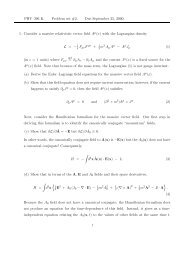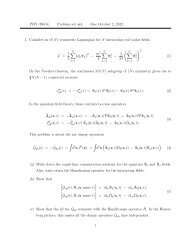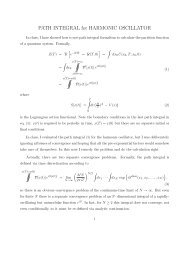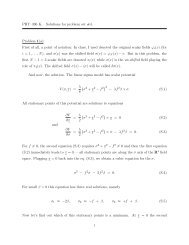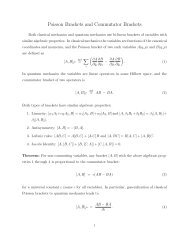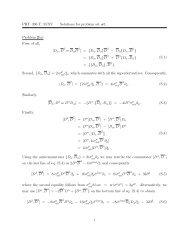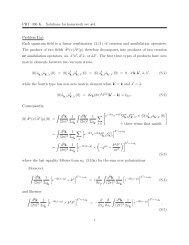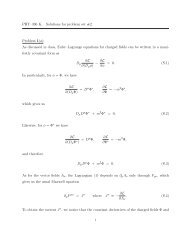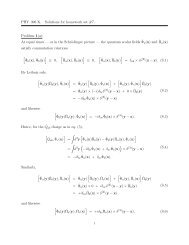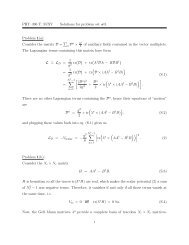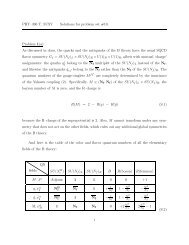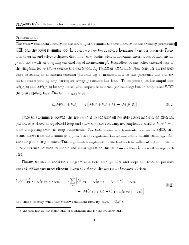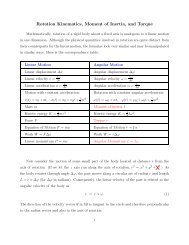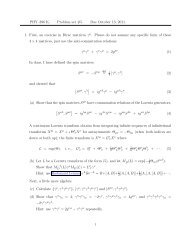PHYâ396 K. Solutions for problem set #6. Problem 1(a): The theory ...
PHYâ396 K. Solutions for problem set #6. Problem 1(a): The theory ...
PHYâ396 K. Solutions for problem set #6. Problem 1(a): The theory ...
Create successful ePaper yourself
Turn your PDF publications into a flip-book with our unique Google optimized e-Paper software.
PHY–396 K. <strong>Solutions</strong> <strong>for</strong> <strong>problem</strong> <strong>set</strong> <strong>#6.</strong><br />
<strong>Problem</strong> 1(a):<br />
<strong>The</strong> <strong>theory</strong> in question has one gauge field A µ (x), so it has one local U(1) symmetry,<br />
φ a (x) → e +iθ(x) φ a (x), φ ∗ a(x) → e −iθ(x) φ ∗ a(x), A µ (x) → A µ (x) − 1 e ∂ µθ(x),<br />
D µ φ a (x) → e +iθ(x) D µ φ a (x), D µ φ ∗ a(x) → e −iθ(x) D µ φ ∗ a(x), F µν (x) → F µν (x).<br />
(S.1)<br />
<strong>The</strong>re are no other local symmetries, but there are global symmetries which mix the φ a with<br />
each other but do not act on the A µ (x). Such symmetries may not mix fields of different<br />
charges with each other because that would screw up their couplings to the A µ , so we are<br />
limited to complex linear trans<strong>for</strong>ms<br />
φ a (x) → U b<br />
a φ b (x),<br />
(S.2)<br />
or in matrix notations<br />
φ(x) → Uφ(x), φ † (x) → φ † (x) U † . (S.3)<br />
<strong>The</strong> matrix U here should be unitary to preserve the<br />
∑<br />
|φ a | 2 ≡ φ † φ → φ † U † Uφ (S.4)<br />
a<br />
and the kinetic term<br />
∑<br />
|D µ φ a | 2 ≡ (D µ φ) † (D µ φ) → (D µ φ) † U † U(D µ φ). (S.5)<br />
a<br />
This suggest that the global symmetry group of the <strong>theory</strong> is U(N).<br />
1
Mathematically, the U(N) group is a direct product SU(N) × U(1) where the SU(N)<br />
factor comprises matrices with unit determinant while the U(1) factor corresponds to<br />
φ a (x) → e +iθ φ a (x), φ ∗ a(x) → e −iθ φ ∗ a(x), sameθ ∀a. (S.6)<br />
Clearly, such global U(1) trans<strong>for</strong>ms are simply special cases of the local U(1) symmetry (S.1)<br />
<strong>for</strong> θ(x) = const, so they do not make a separate global symmetry. <strong>The</strong>re<strong>for</strong>e, the global<br />
symmetry group of the <strong>theory</strong> is SU(N) rather than U(N).<br />
<strong>Problem</strong> 1(b):<br />
According to part (a), symmetries act on scalar fields as<br />
φ a (x) → e iθ(x) U b<br />
a φ b (x), U = const, U † U = 1. (S.7)<br />
To preserve the vacuum expectation values 〈φ a 〉 = vδ a,N such a trans<strong>for</strong>m must have<br />
(α)<br />
(β)<br />
U N<br />
i = 0 <strong>for</strong> i = 1, . . . , (N − 1),<br />
U N<br />
N<br />
× eiθ(x) ≡ 1 ∀x.<br />
Condition (β) implies θ = const, so all symmetries preserving the VEVs are global rather<br />
than local.<br />
For a unitary matrix U, condition (α) requires U to be block-diagonal,<br />
U =<br />
⎛<br />
⎜<br />
⎝<br />
⎞<br />
0<br />
Ũ .<br />
⎟<br />
0 ⎠<br />
0 · · · 0 e −iξ<br />
(S.8)<br />
where Ũ is a unitary (N − 1) × (N − 1) matrix and ξ is some real phase. To satisfy (β) we<br />
need ξ = θ, and we also need det(U) = det(Ũ) × e−iξ = 1. Consequently, Ũ = eiξ/(N−1) × W<br />
where det W = 1.<br />
2
Altogether, we have unbroken symmetries acting on the fields as<br />
φ N (x) → φ N (x),<br />
N−1<br />
∑<br />
φ i (x) → e iNξ/(N−1)<br />
j=1<br />
W j<br />
i<br />
φ j (x),<br />
W ∈ SU(N − 1), e iξ ∈ U(1), same W and e iξ ∀x. (S.9)<br />
<strong>The</strong>se are global symmetries, and the group is SU(N − 1) × U(1).<br />
<strong>Problem</strong> 1(c): <strong>The</strong> symmetry group of the <strong>theory</strong> G = SU(N) × U(1) ∼ = U(N) has N 2<br />
generators. <strong>The</strong> group of unbroken symmetries H = SU(N −1)×U(1) ∼ = U(N −1) has (N −1) 2<br />
generators. Consequently, the spontaneously broken symmetries comprise U(N)/U(N − 1),<br />
and the number of broken generators is N 2 − (N − 1) 2 = 2N − 1. Had all the symmetries<br />
were global, this would require 2N − 1 massless Goldstone scalars.<br />
However, one of the broken symmetries is local rather than global, and the corresponding<br />
Goldstone scalar is eaten up by the Higgs mechanism which makes the vector field A µ massive.<br />
This leaves us with only 2N − 2 massless Goldstone scalars.<br />
To determine their U(N − 1) quantum numbers we need a little group <strong>theory</strong>. A nonabelian<br />
symmetry group acts non-trivially on its own generators, T α → UT α U −1 ≠ T α .<br />
However, the generators trans<strong>for</strong>m linearly into each other; together, they <strong>for</strong>m an adjoint<br />
multiplet where<br />
T α → UT α U −1 = ∑ β<br />
Adj(U) α,β × T β .<br />
(S.10)<br />
For the U(N) group, the adjoint multiplet is equivalent to N × N where N is the fundamental<br />
multiplet of the group (N complex members) and N is its complex conjugate. In other words,<br />
we may label the N 2 generators of the U(N) as T b<br />
a , and they trans<strong>for</strong>m into each other exactly<br />
as the field products φ a × φ ∗b . <strong>The</strong> unbroken U(N − 1) symmetry is generated by the T j<br />
i<br />
with i, j < N; naturally, these generators <strong>for</strong>m the adjoint multiplet of the U(N − 1). <strong>The</strong><br />
remaining, broken generators are as follows:<br />
• <strong>The</strong> T N<br />
i with i < N, which comprise the fundamental N − 1 multiplet of the U(N − 1).<br />
3
• <strong>The</strong> T j<br />
N<br />
U(N − 1).<br />
with j < N, which comprise the anti-fundamental N − 1 multiplet of the<br />
• <strong>The</strong> TN N , which is a singlet of the U(N − 1).<br />
Thus, we expect N − 1 charged Goldstone scalars in a fundamental N − 1 multiplet of<br />
the U(N − 1). <strong>The</strong>ir antiparticles make an anti-fundamental N − 1 multiplet. For a global<br />
U(N) symmetry there would also be a neutral Goldstone boson in a singlet multiplet of the<br />
U(N − 1), but because the U(1) symmetry is global, this singlet is eaten up by the Higgs<br />
mechanism: It becomes the longitudinal polarization of the massive vector instead of a scalar<br />
particle of its own right.<br />
PS: <strong>The</strong> above counting of broken generators and Goldstone bosons is correct, but the full<br />
story of the singlet is a bit more complicated. Because the U(N) group is not simple but a<br />
product SU(N) × U(1), the adjoint multiplet of the U(N) is reducible. <strong>The</strong> U(1) generator<br />
∑a T a<br />
a<br />
is a singlet, while the remaining N 2 − 1 combinations of the T b<br />
a<br />
multiplet of the SU(N).<br />
<strong>for</strong>m the adjoint<br />
From the unbroken U(N − 1) = SU(N − 1) × U(1) point of view, the adjoint of the<br />
U(N) contains two singlets, the ∑ a T a<br />
a<br />
∈ Adj[U(1) local ] and the ∑ i T i<br />
i<br />
− (N − 1)T N<br />
N<br />
Adj[SU(N) global ]. One linear combination of these two singlets — namely the TN<br />
N — is<br />
broken by the VEV 〈φ N 〉 ̸= 0, while the other combination ∑ i T i<br />
i remains unbroken, but<br />
only as a global symmetry. But despite this mixing of the two singlets, the overall symmetry<br />
breaking pattern<br />
∈<br />
U(N − 1) singlets : 1 local + 1 global → 1 broken + 1 global (S.11)<br />
has the same effect as if there was only one singlet, which used to generate a local symmetry<br />
but became spontaneously broken. Consequently, there are no SU(N − 1)–singlet Goldstone<br />
particles; instead, one real scalar field becomes eaten by the Higgs mechanism when the A µ<br />
field becomes massive.<br />
4
<strong>Problem</strong> 1(d):<br />
For m 2 < 0, the scalar potential<br />
V = λ 4 (φ† φ) 2 + m 2 φ † φ (S.12)<br />
is minimized <strong>for</strong><br />
φ † φ = v2<br />
2 = −2m2<br />
λ<br />
> 0. (S.13)<br />
<strong>The</strong>se minima <strong>for</strong> a sphere in the field space, and without loss of generality, we work with the<br />
vacuum states where fields’ expectation values lie at the “North pole” of this sphere,<br />
〈φ N 〉 = v × δ a,n . (S.14)<br />
<strong>The</strong> excited states near this vacuum have φ N (x) ≠ 0 (expect along some singular lines, which<br />
should be few and far between), so we may impose a unitary gauge <strong>for</strong> the vector fields by<br />
requiring<br />
phase (φ N (x)) ≡ 0 ∀x. (S.15)<br />
Note that the phases of the remaining φ i (x) fields remain unconstrained.<br />
Now let’s shift the φ N field by its VEV,<br />
φ N (x) = v + σ(x) √<br />
2<br />
,<br />
while the remaining φ i (x) scalars stay as they are. In terms of the real σ(x) field and the<br />
complex φ i (x) fields, the scalar potential becomes<br />
V = const + λ 4<br />
( ∑<br />
i<br />
|φ i | 2 +<br />
(v + σ)2<br />
2<br />
) 2<br />
− v2<br />
2<br />
= const + λv2<br />
4 × σ2 + cubic + quartic.<br />
(S.16)<br />
<strong>The</strong> kinetic terms |D µ φ i | 2 of the un-shifted φ i fields remain as they are, but the kinetic term<br />
5
<strong>for</strong> the φ N becomes<br />
|D µ Φ N | 2 = 1 2 |∂ µσ + eA µ (v + σ)| 2 =<br />
2 1(∂ µσ) 2 + e2 (v + σ) 2<br />
A µ A µ .<br />
2<br />
(S.17)<br />
Altogether, we have<br />
L = − 1 4 F µνF µν + e2 (v + σ) 2<br />
A µ A µ<br />
2<br />
+ ∑ i<br />
|∂ µ φ i + ieA µ φ i | 2 + 1 2 (∂ µσ) 2 − V (σ, |φ i |)<br />
= const + L 2 + L 3+4<br />
(S.18)<br />
where the quadratic terms in<br />
L 2 = − 1 4 F µνF µν + e2 v 2<br />
2 A µA µ + ∑ i<br />
|∂ µ φ i | 2 + 1 2 (∂ µσ) 2 − λv2<br />
4 σ2 (S.19)<br />
determines the particles of the <strong>theory</strong>, while the cubic and quartic terms in the L 3+4 govern<br />
their interactions. Specifically, the quadratic Lagrangian (S.19) describes:<br />
• One massive vector field A µ of mass = ev.<br />
• One massive neutral scalar field σ of mass 2 = 1 2 λv2 = −2m 2 > 0.<br />
• N − 1 charged massless scalar fields φ i . <strong>The</strong>se are the Goldstone bosons of the broken<br />
global symmetries.<br />
<strong>Problem</strong> 2(e):<br />
A charged quantum field such as ˆφ i (x) together with its hermitian conjugate ˆφ † i<br />
(x) describe<br />
a particle and a distinct antiparticle. <strong>The</strong> ˆφ i (x) comprises operators which create particles<br />
or annihilate antiparticles, while the ˆφ † i<br />
(x) comprises operators which create antiparticles or<br />
annihilate particles.<br />
For the <strong>problem</strong> at hand, the N − 1 charged scalar fields ˆφ i create and annihilate 2 ×<br />
(N − 1) massless particles species, the N − 1 multiplet of particles, and the N − 1 multiplet<br />
of antiparticles. Clearly, these are precisely the Goldstone particles we expect from part (c).<br />
Q.E.D.<br />
6
<strong>Problem</strong> 2(a):<br />
given Φ → e +iθ U L ΦU † R , (4)<br />
we have Φ † → e −iθ U R Φ † U † L , (S.20)<br />
hence Φ † Φ → U R (Φ † Φ)U † R , (S.21)<br />
(<br />
Φ † Φ ) 2 → UR Φ † ΦU † R U RΦ † ΦU † R = U R(<br />
Φ † Φ ) 2 U<br />
†<br />
R , (S.22)<br />
(<br />
likewise Φ † Φ ) n (<br />
→ UR Φ † Φ ) n U<br />
†<br />
R<br />
∀n = 1, 2, 3, . . . , (S.23)<br />
and there<strong>for</strong>e<br />
all traces tr<br />
( (Φ † Φ ) n ) are invariant under (4), (S.24)<br />
thanks to the cyclic invariance rule <strong>for</strong> traces. ⋆<br />
invariant under symmetries (4).<br />
Consequently, the scalar potential (3) is<br />
For the global symmetries where e iθ , U L , and U R do not depend on x, the kinetic term<br />
in (2) is also invariant. Indeed,<br />
<strong>for</strong> constant e iθ , U L , U R ,<br />
∂ µ Φ → e +iθ U L (∂ µ Φ)U † R ,<br />
∂ µ Φ † → e −iθ U R (∂ µ Φ † )U † L ,<br />
(S.27)<br />
∂ µ Φ † ∂ µ Φ → U R (∂ µ Φ † ∂ µ Φ)U † R ,<br />
and tr ( ∂ µ Φ † ∂ µ Φ ) is invariant.<br />
Q.E.D.<br />
⋆ Trace of a product of two matrices does not depend on the order of multiplication, tr(AB) = tr(BA).<br />
Consequently, trace of a product of several matrices is not affected by cyclic permutations of the factors,<br />
tr(ABC · · · XY Z) = tr(BC · · · XY ZA) = tr(C · · · XY ZAB) = · · · = tr(ZABC · · · XY ).<br />
(S.25)<br />
In particular, <strong>for</strong> any unitary matrix U and any matrix A,<br />
tr(UAU † ) = tr(AU † U) = tr(A).<br />
(S.26)<br />
<strong>The</strong> invariance (S.24) follows from eq. (S.23) by this rule.<br />
7
<strong>Problem</strong> 2(⋆):<br />
<strong>The</strong> kinetic term in (2) and the last two terms in the potential (3) have a much bigger<br />
symmetry than G, namely SO(2N 2 ), which does not care <strong>for</strong> the matrix structure of the Φ(x)<br />
and treats it as 2N 2 real component fields. Indeed,<br />
(<br />
tr Φ † Φ) = ∑ i,j<br />
∣<br />
∣Φ j<br />
i<br />
∣<br />
∣ 2<br />
= ∑ i,j<br />
( ( ) 2 ( ) ) 2<br />
Re Φ j<br />
i + Im Φ j<br />
i<br />
(S.28)<br />
is invariant under all SO(2N 2 ) “rotations” of the components, and so is the kinetic term.<br />
On the other hand, the tr ( Φ † Φ Φ † Φ ) in the potential does depend on the packing of 2N 2<br />
real components into a complex N × N matrix, and it is this term which reduces the internal<br />
symmetry group of the <strong>theory</strong> to G = SU(N) × SU(N) × U(1).<br />
Proving that all the SO(2N 2 )/G symmetries are broken by the quartic trace term is a<br />
non-trivial exercise in group <strong>theory</strong> rather than field <strong>theory</strong>. You do not have to do it as part<br />
of this homework <strong>set</strong>, and I am not writing down the proof here.<br />
<strong>Problem</strong> 2(b):<br />
Given the eigenvalues (κ 1 , . . . , κ N ) of the Φ † Φ matrix, the invariant traces (S.24) obtain as<br />
tr<br />
( (Φ † Φ ) n ) =<br />
N∑<br />
κ n i .<br />
i=1<br />
(S.29)<br />
Consequently, the scalar potential is<br />
( ∑<br />
i<br />
V = α 2<br />
∑<br />
κ 2 i + β 2<br />
i<br />
κ i<br />
) 2<br />
+ m 2 ∑ i<br />
κ i .<br />
(S.30)<br />
Now let’s minimize this potential. Since the matrix Φ † Φ cannot have any negative eigenvalues,<br />
we are looking <strong>for</strong> a minimum of V (κ 1 , . . . , κ N ) under constraints κ i ≥ 0. This requires<br />
∀i = 1, . . . , N,<br />
either κ i ≥ 0 and ∂V<br />
∂κ i<br />
= 0, or else κ i = 0 and ∂V<br />
∂κ i<br />
> 0, (S.31)<br />
8
where<br />
∂V<br />
∂κ i<br />
= ακ i + m 2 + β ∑ j<br />
κ j .<br />
(S.32)<br />
<strong>The</strong> solutions of these equations are as follows:<br />
• For α > 0, β > 0, and m 2 > 0, the only solution is κ 1 = · · · κ N = 0 and hence 〈Φ〉 = 0.<br />
• For α > 0, β > 0, and m 2 < 0, the only solutions is (5) and hence 〈Φ〉 = C × a unitary<br />
matrix. We shall focus on this regime in parts (c–e) of this <strong>problem</strong> and in <strong>problem</strong> 3.<br />
• For α < 0 or β < 0, the situation is more complicated:<br />
— When α + β < 0 or α + Nβ < 0, the scalar potential (3) is unbounded from below<br />
and the <strong>theory</strong> is sick.<br />
— When α > 0 and β < 0 but α + Nβ > 0, the solutions are similar to the β > 0 case:<br />
For m 2 > 0 all κ i = 0, while <strong>for</strong> m 2 < 0 the κ i are as in eq. (5).<br />
— When β > 0 and α < 0 but α+β > 0, there is only one 〈φ〉 = 0 solution <strong>for</strong> m 2 > 0,<br />
but there are N distinct solutions <strong>for</strong> m 2 < 0, namely <strong>for</strong> k = 1, 2, . . . , N,<br />
κ 1 = · · · = κ k = −m2<br />
α + kβ > 0, κ k+1 = · · · = κ N = 0 (S.33)<br />
(modulo permutations of the eigenvalues). <strong>The</strong> deepest minimum of V corresponds<br />
to the k = 1 solution.<br />
<strong>Problem</strong> 2(c):<br />
Let’s act with some SU(N) L × SU(N) R × U(1) symmetry (4) on the vacuum expectation<br />
values (6):<br />
〈Φ〉 = C × 1 N×N → e iθ U L 〈Φ〉 U † R = C × eiθ U L U † R . (S.34)<br />
Clearly, to keep the VEVs 〈Φ〉 invariant, we need<br />
e iθ U L U † R = 1 N×N (S.35)<br />
9
and hence<br />
U R = e iθ × U L . (S.36)<br />
Moreover, since the U L and U R matrices have unit determinants, this means<br />
e iθ = 1 and U L = U R ∈ SU(N). (S.37)<br />
In other words, the unbroken symmetry group is SU(N) which acts on the scalar fields as<br />
Φ(x) → UΦ(x) U † , U ∈ SU(N). (S.38)<br />
<strong>Problem</strong> 2(d):<br />
In terms of the shifted fields (7),<br />
∂ µ Φ = 1 √<br />
2<br />
(∂ µ ϕ 1 + i∂ µ ϕ 2 ) , ∂ µ Φ † = 1 √<br />
2<br />
(∂ µ ϕ 1 − i∂ µ ϕ 2 ) ,<br />
(S.39)<br />
hence the kinetic term in the Lagrangian becomes<br />
tr ( ∂ µ Φ † ∂ µ Φ ) = 1 2 tr(∂ µϕ 1 ∂ µ ϕ 1 ) + 1 2 tr(∂ µϕ 2 ∂ µ ϕ 2 ).<br />
(S.40)<br />
As to the potential terms,<br />
tr ( Φ † Φ ) = NC 2 + √ 2C tr(ϕ 1 ) + 1 2 tr(ϕ2 1) + 1 2 tr(ϕ2 2),<br />
tr 2( Φ † Φ ) = N 2 C 4 + 2 √ 2NC 3 tr(ϕ 1 ) + 2C 2 tr 2 (ϕ 1 ) + NC 2 ( tr(ϕ 2 1) + tr(ϕ 2 2) )<br />
+ √ 2C tr(ϕ 1 ) × ( tr(ϕ 2 1) + tr(ϕ 2 2) ) + 1 4<br />
tr<br />
( (Φ † Φ ) 2 ) = NC 4 + 2 √ 2C 3 tr(ϕ 1 ) + 3C 2 tr(ϕ 2 1) + C 2 tr(ϕ 2 2)<br />
+ √ 2C tr(ϕ 3 1) + √ 2C tr(ϕ 1 ϕ 2 2)<br />
(<br />
tr(ϕ<br />
2<br />
1 ) + tr(ϕ 2 2) ) 2<br />
and there<strong>for</strong>e<br />
+ 1 4 tr(ϕ4 1) + 1 4 tr(ϕ4 2) + 3 2 tr(ϕ2 1ϕ 2 2) − 1 2 tr(ϕ 1ϕ 2 ϕ 1 ϕ 2 ),<br />
(S.41)<br />
V = const + V 1 + V 2 + V 3 + V 3 , (S.42)<br />
10
V 1 = √ 2C × (m 2 + βNC 2 + αC 2 ) × tr(ϕ 1 )<br />
= 0 (S.43)<br />
because m 2 + (α + Nβ)C 2 = 0, (S.44)<br />
V 2 = βC 2 × tr 2 (ϕ 1 ) + 1 2 (m2 + βNC 2 + 3αC 2 ) × tr(ϕ 2 1)<br />
V 3<br />
+ 1 2 (m2 + βNC 2 + αC 2 ) × tr(ϕ 2 2)<br />
= βC 2 × tr 2 (ϕ 1 ) + αC 2 tr(ϕ 2 1) + 0, (S.45)<br />
= βC<br />
(<br />
)<br />
√ × tr(ϕ 1 ) × tr(ϕ 2 1) + tr(ϕ 2 2)<br />
2<br />
) 2<br />
+ αC (<br />
)<br />
√ × tr(ϕ 3 1) + tr(ϕ 1 ϕ 2 2) , (S.46)<br />
2<br />
V 4 = β (<br />
tr(ϕ 2<br />
8<br />
1) + tr(ϕ 2 2)<br />
+ α (<br />
)<br />
tr(ϕ 4<br />
8<br />
1) + tr(ϕ 4 2) + 6 tr(ϕ 2 1ϕ 2 2) − 2 tr(ϕ 1 ϕ 2 ϕ 1 ϕ 2 ) . (S.47)<br />
Combining the quadratic part (S.45) of this potential with the kinetic terms (S.40), we<br />
arrive at<br />
L 2 = 1 2 tr(∂ µϕ 1 ∂ µ ϕ 1 ) − βC 2 × tr 2 (ϕ 1 ) − αC 2 tr(ϕ 2 1) + 1 2 tr(∂ µϕ 1 ∂ µ ϕ 2 ) (S.48)<br />
which gives us the mass spectrum of the <strong>theory</strong>: the ϕ 1 (x) matrix of fields is massive and the<br />
ϕ 2 (x) matrix is massless. Each matrix is N ×N and hermitian, so it contains N 2 independent<br />
real scalar fields, which give rise to N 2 particles. Altogether, the spectrum comprises:<br />
• N 2 massless particles from the ϕ 2 (x) matrix.<br />
• N 2 − 1 massive particles with M 2 = 2αC 2 from the traceless part of the ϕ 1 (x) matrix.<br />
• One more massive particle with M 2 = 2(α + Nβ)C 2 = −2m 2 from the trace of ϕ 1 (x).<br />
To see where the values of the masses come from, let’s decompose the ϕ 1 matrix into pure<br />
trace plus traceless part,<br />
ϕ 1 (x) = ξ(x) √<br />
N<br />
× 1 N×N + ˜ϕ 1 (x) where tr( ˜ϕ 1 ) ≡ 0. (S.49)<br />
Consequently,<br />
tr 2 (ϕ 1 ) = N × ξ 2 , tr(ϕ 2 1) = ξ 2 + tr( ˜ϕ 2 1), (S.50)<br />
11
and ditto <strong>for</strong> the kinetic term. Thus, the free Lagrangian (S.48) becomes<br />
L 2 = 1 2 (∂ µξ) 2 − 2(βC 2 N + αC 2 ) × 1 2 ξ2<br />
+ 1 2 tr( (∂ µ ˜ϕ 1 ) 2) − 2αC 2 × 1 2 tr( ˜ϕ2 1)<br />
(S.51)<br />
where all the masses are manifest.<br />
+ 1 2 tr( (∂ µ ϕ 2 ) 2) − 0 × 1 2 tr(ϕ2 2)<br />
<strong>Problem</strong> 2(e):<br />
<strong>The</strong> unbroken SU(N) symmetry acts on the scalar fields according to eq. (S.38), or in terms<br />
of the shifted fields,<br />
ϕ 1 (x) → Uϕ 1 (x) U † , ϕ 2 (x) → Uϕ 2 (x) U † . (S.52)<br />
To make the SU(N) multiplet structure manifest, let’s decompose both ϕ 1 and ϕ 2 into their<br />
traceless parts and pure traces along the lines of eq. (S.49),<br />
ϕ 1 (x) = ξ 1(x)<br />
√<br />
N<br />
× 1 N×N + ˜ϕ 1 (x), ϕ 2 (x) = ξ 2(x)<br />
√<br />
N<br />
× 1 N×N + ˜ϕ 2 (x), tr( ˜ϕ 1 ) ≡ tr( ˜ϕ 2 ) ≡ 0.<br />
(S.53)<br />
With this decomposition, the ξ 1 and the ξ 2 are both invariant under the SU(N) — which<br />
puts each of them into its own singlet multiplet — while the each of the traceless parts ˜ϕ 1<br />
and ˜ϕ 2 makes each own adjoint multiplet.<br />
This multiplet structure agrees with the masses we obtained in part (d).<br />
Indeed, all<br />
N 2 − 1 members of the adjoint multiplet ˜ϕ 1 have the same mass 2αC 2 , while the singlet ξ 1<br />
has a different mass 2(α + Nβ)C 2 .<br />
On the other hand, both the adjoint multiplet ˜ϕ 2 and the singlet ξ 2 are massless. <strong>The</strong><br />
reason <strong>for</strong> this degeneracy goes beyond the un-broken SU(N) symmetry; instead, both the<br />
˜ϕ 2 and the ξ 2 are Goldstone bosons of the spontaneously broken symmetries in<br />
G/H =<br />
(<br />
) /<br />
SU(N) L × SU(N) R × U(1) SU(N) .<br />
(S.54)<br />
Specifically, the singlet ξ 2 is the Goldstone boson of the broken U(1) symmetry. Indeed, the<br />
U(1)’s generator commutes with all the other generators, so it belongs in its own singlet of<br />
the symmetry, and the corresponding Goldstone particle should also be a singlet.<br />
12
Now consider the non-abelian generators. Generators TL a of the SU(N) L <strong>for</strong>m an adjoint<br />
multiplet of the SU(N) L , but are invariant under the SU(N) R . Likewise, generators TR a of<br />
the SU(N) R <strong>for</strong>m an adjoint multiplet of the SU(N) R , but are invariant under the SU(N) L .<br />
In other words, under an (U L , U R ) ∈ SU(N) L × SU(N) R they trans<strong>for</strong>m as<br />
T a L → U LT a L U † L , T a R → U RT a R U † R . (S.55)<br />
When the SU(N) L × SU(N) R is broken down to a single SU(N) spanning U L = U R = U,<br />
both T a L and T a R<br />
trans<strong>for</strong>m as<br />
T a L → UT a L U † , T a R → UT a R U † , (S.56)<br />
which puts them into two adjoint multiplets of the unbroken SU(N). Equivalently, we may<br />
<strong>for</strong>m two adjoint multiplets out of<br />
T a V = T a L + T a R and T a A = T a L − T a R , (S.57)<br />
which act on the scalar fields according to<br />
T a V Φ = i 2 [λa , Φ], T a A Φ = i 2 {λa , Φ}. (S.58)<br />
<strong>The</strong> T a V generate the unbroken SU(N) symmetry, cf. eq. (S.38). <strong>The</strong> T a A<br />
generators are spontaneously<br />
broken, hence there should be an adjoint multiplet of massless Goldstone bosons.<br />
And indeed there is — the ˜ϕ 2 .<br />
<strong>Problem</strong> 3(a):<br />
When a gauge symmetry is spontaneously broken, mass terms <strong>for</strong>m the gauge fields come<br />
from kinetic terms of scalars with non-zero VEVs (vacuum expectation values). <strong>The</strong> simplest<br />
way to separate the vector mass terms from shifted scalars’ kinetic energies and scalar-vector<br />
13
interactions is to freeze the scalar fields to their VEVs. Indeed, let’s freeze Φ(x) ≡ 〈Φ〉 =<br />
C × 1 N×N . <strong>The</strong>n according to eq. (9),<br />
D µ 〈Φ〉 = ig ′ B µ 〈Φ〉 + igL µ 〈Φ〉 − ig 〈Φ〉 R µ<br />
= ig ′ C B µ × 1 N×N + igC × (L µ − R µ )<br />
= ig ′ C B µ × 1 N×N + igC ∑<br />
(L a µ − R a<br />
2<br />
µ) × λ a ,<br />
a<br />
(S.59)<br />
and consequently<br />
( (Dµ<br />
tr 〈Φ〉 †)( D µ 〈Φ〉 )) = Ng ′2 C 2 × B µ B µ + g2 C 2<br />
2<br />
∑<br />
(L a µ − Rµ)(L a aµ − R aµ ). (S.60)<br />
a<br />
Thus, the abelian B µ field has mass M 2 B = 2Ng′2 C 2 while the non-abelian fields L a µ and R a µ<br />
have non-diagonal mass terms. To diagonalize those terms, let’s mix the fields according to<br />
Vµ a = √ 1 (<br />
L<br />
a<br />
µ + R a )<br />
µ , X<br />
a<br />
µ = 1 (<br />
√ L<br />
a<br />
µ − Rµ) a , (S.61)<br />
2 2<br />
where the 1/ √ 2 coefficients make the V a µ and X a µ canonically normalized, i.e.<br />
L kin<br />
L,R = −1 4<br />
∑<br />
a<br />
( ( 2 ( ) ) 2<br />
∂ [µ Lν]) a + ∂ [µ Rν]<br />
a<br />
= − 1 ∑<br />
( ( ) 2 ( ) ) 2<br />
∂<br />
4 [µ Vν]<br />
a + ∂ [µ Vν]<br />
a . (S.62)<br />
a<br />
In terms of the V a µ and X a µ, the mass terms <strong>for</strong> L a µ and R a µ in eq. (S.60) become<br />
L masses<br />
L,R = g 2 C 2 × X a µX aµ . (S.63)<br />
Thus, the V a µ fields remain massless while the X a µ acquire common mass M 2 X = 2g2 C 2 .<br />
14
<strong>Problem</strong> 3(b):<br />
Higgs mechanism which makes the Xµ a and B µ vector fields massive “eats” the Goldstone<br />
bosons ˜ϕ a 2 and ξ 2. This is particularly manifest in the unitary gauge where the Φ(x) matrix<br />
is always hermitian and hence ϕ 2 (x) ≡ 0. ⋆ Hence, all the remaining scalar fields are massive,<br />
and the only massless fields in the <strong>theory</strong> are the vectors fields Vµ a .<br />
To write down an effective <strong>theory</strong> <strong>for</strong> the massless fields, we simply freeze all the massive<br />
fields B µ , Xµ, a ˜ϕ 1 , and ξ 1 ; only the massless Vµ a remain un-frozen. In other words, we let<br />
Φ(x) ≡ 〈Φ〉 = C × 1 N×N , B µ (x) ≡ 0, L a µ(x) = R a µ(x) = 1 √<br />
2<br />
V a µ (x),<br />
(S.66)<br />
and then substitute these values into the Lagrangian (8). According to eq. (S.59), <strong>for</strong> fields as<br />
in eq. (S.66), D µ Φ = 0, so only the terms involving L µν and R µν remain unfrozen. Specifically,<br />
in matrix notations<br />
L µν = R µν = √ 1 ( ) ig [<br />
∂µ V ν − ∂ ν V µ + Vµ , V ν , ] , (S.67)<br />
2 2<br />
or in components<br />
L a µν = Rµν a = √ 1 (<br />
∂µ Vν a − ∂ ν V a ) g<br />
µ − 2 2 f abc Vµ b Vν<br />
c<br />
(S.68)<br />
where f abc are the structure constants of the SU(N) group. In other words,<br />
L a µν = R a µν = 1 √<br />
2<br />
V a µν<br />
(S.69)<br />
⋆ Let’s rewrite the symmetry (4) as<br />
Φ → W UΦ U † where W ∈ U(N), U ∈ SU(N). (S.64)<br />
Using just the W part of this symmetry, me can make any matrix Φ hermitian, Φ → √ Φ † Φ; this<br />
trans<strong>for</strong>m is non-singular as long as Φ † Φ has no zero eigenvalues. For the local symmetry<br />
Φ(x) → W (x)U(x)Φ(x) U † (x),<br />
(S.65)<br />
we may use W (x) to keep Φ(x) hermitian everywhere; this amounts to fixing the unitary gauge <strong>for</strong> the<br />
broken symmetries.<br />
Note that the Φ † ≡ Φ condition fixes the W (x) but still allows <strong>for</strong> an arbitrary U(x). Consequently,<br />
the un-broken SU(N) gauge symmetry remains un-fixed.<br />
15
where<br />
V a µν<br />
= ∂ µ Vν a − ∂ ν Vµ a − √ g f abc Vµ b Vν<br />
c<br />
2<br />
(S.70)<br />
are the non-abelian tension fields <strong>for</strong> the vector potential fields Vµ a .<br />
Thus,<br />
L unfrozen = − 1 2 tr(L µνL µν ) − 1 2 tr(R µνR µν )<br />
= − 1 ∑ ( (L )<br />
a 2 ( ) )<br />
4 µν + R<br />
a 2<br />
µν<br />
a<br />
(S.71)<br />
= − 1 ∑( )<br />
V<br />
a 2<br />
4 µν<br />
a<br />
— the Yang–Mills Lagrangian <strong>for</strong> the Vµ a fields. <strong>The</strong> gauge coupling <strong>for</strong> those fields follows<br />
from eq. (S.70): g V = g/ √ 2.<br />
<strong>Problem</strong> 3(⋆):<br />
Let’s start with the non-abelian vector fields. In terms of V µ and X µ ,<br />
L µ = 1 √<br />
2<br />
(V µ + X µ ) ,<br />
L µν = 1 √<br />
2<br />
V µν + 1 √<br />
2<br />
(∂ µ X ν − ∂ ν X µ ) + ig 2 ([V µ, X ν ] − [V ν , X µ ]) + ig 2 [X µ, X ν ]<br />
(S.72)<br />
= 1 √<br />
2<br />
V µν + 1 √<br />
2<br />
(<br />
ˆDµ X ν − ˆD ν X µ<br />
)<br />
+ ig 2 [X µ, X ν ]<br />
where V µν defined in eq. (S.70) is the tension field of V µ and ˆD µ are derivatives covariant with<br />
respect to the un-broken SU(N) V ,<br />
ˆD µ X = ∂ µ X + ig V [V µ , X] <strong>for</strong> any adjoint X. (S.73)<br />
Similarly,<br />
R µν = 1 √<br />
2<br />
V µν − 1 √<br />
2<br />
(<br />
ˆDµ X ν − ˆD ν X µ<br />
)<br />
+ ig 2 [X µ, X ν ]. (S.74)<br />
16
Combining eqs. (S.72) and (S.74) together, we find<br />
L YM<br />
= − 1 2 tr( L µν L µν) − 1 2 tr( R µν R µν)<br />
= − 1 2 tr ( (Vµν<br />
+ ig V [X µ , X ν ] ) 2 ) − 1 2 tr ( ( ˆDµ X ν − ˆD ν X µ<br />
) 2<br />
)<br />
after a bit of algebra<br />
( (<br />
= − 1 2 tr (V µνV µν )(<br />
) − tr ˆDµ X ˆDµ ν X ν)) ( (<br />
+ tr ˆDµ X µ) ) 2<br />
− 2ig V tr ( V µν [X µ , X ν ] ) − 1 2 g2 V tr( −[X µ , X ν ] [X µ , X ν ] )<br />
= − 1 4<br />
∑<br />
a<br />
+ g V<br />
2<br />
(<br />
V<br />
a<br />
µν<br />
) 2 −<br />
1<br />
2<br />
∑<br />
∑<br />
f abc VµνX a bµ X cν<br />
abc<br />
a<br />
( ( ˆDµ Xν<br />
a ) 2 ( )<br />
− ˆDµ Xµ) a 2<br />
+ g2 V<br />
4<br />
∑<br />
f abc f ade XµX b νX c dµ X eν .<br />
abcde<br />
(S.75)<br />
Altogether, we have covariant kinetic energy terms <strong>for</strong> the V and X vector fields as well as<br />
interactions between V ’s and X’s and also among X’s themselves.<br />
Next, consider<br />
D µ Φ = ∂ µ Φ + ig V (V µ + X µ )Φ − ig V Φ(V µ − X µ ) + ig ′ B µ Φ<br />
= ∂ µ Φ + ig V [V µ , Φ] + ig V {X µ , Φ} + ig ′ B µ Φ<br />
(S.76)<br />
= ˆD µ Φ + ig V {X µ , Φ} + ig ′ B µ Φ.<br />
In the unitary gauge where the Φ(x) matrix is always hermitian, the first term on the last line<br />
of (S.76) is hermitian while the other two terms are anti-hermitian. Consequently,<br />
(<br />
)<br />
tr (D µ Φ † )(D µ Φ)<br />
(<br />
= tr ( ˆD µ Φ) 2) ( (gV<br />
+ tr {X µ , Φ} + g ′ B µ Φ ) ) 2<br />
. (S.77)<br />
<strong>The</strong> first term on the right hand side here provides SU(N) V –covariant kinetic energies <strong>for</strong><br />
the scalar fields, while the second terms contains scalar-dependent masses <strong>for</strong> the vector fields<br />
B µ and Xµ. a To make this manifest, we shift Φ(x) by 〈Φ〉 and then expand into real (in the<br />
unitary gauge) components according to<br />
Φ(x) = C × 1 N×N +<br />
ξ(x) √<br />
2N<br />
× 1 N×N + 1 2<br />
∑<br />
ϕ a (x) × λ a<br />
a<br />
(S.78)<br />
17
In terms of these components,<br />
(<br />
tr ( ˆD µ Φ) 2) =<br />
2 1(∂ µξ) 2 + ∑ a<br />
1<br />
2 ( ˆD µ ϕ a ) 2 (S.79)<br />
while<br />
( (gV<br />
tr {X µ , Φ} + g ′ B µ Φ ) ) 2<br />
= 1 2 M BB(ξ, ϕ) × B µ B µ + ∑ a<br />
+ 1 2<br />
M a BX (ξ, ϕ) × Xa µB µ<br />
∑<br />
a,b<br />
M ab<br />
XX (ξ, ϕ) × Xa µX bµ (S.80)<br />
where<br />
M BB (ξ, ϕ) = g ′2 (<br />
( √<br />
2NC + ξ<br />
) 2<br />
(<br />
M a BX (ξ, ϕ) = g′ g V<br />
(2 C + √ ξ )<br />
× ϕ a + ∑<br />
2N<br />
bc<br />
)<br />
∑<br />
+ (ϕ a ) 2 , (S.81)<br />
a<br />
d abc ϕ b ϕ c )<br />
, (S.82)<br />
M ab<br />
XX (ξ, ϕ) = g2 V<br />
⎛<br />
⎜<br />
⎝<br />
(<br />
C +<br />
ξ √<br />
2N<br />
) 2<br />
× δ ab +<br />
(<br />
C + √ ξ )<br />
× ∑<br />
2N<br />
c<br />
+ 1<br />
2N ϕa ϕ b<br />
+ ∑ cde<br />
⎞<br />
d abc ϕ c<br />
⎟<br />
d acd ϕ d d bce ϕ e ⎠ .<br />
(S.83)<br />
In the last two <strong>for</strong>mulae here, I’ve used<br />
{λ a , λ b } = 2 N δab + 2 ∑ c<br />
d abc λ c<br />
(S.84)<br />
where d abc constants are totally symmetric in all three adjoint indices a, b, c. <strong>The</strong>y exist <strong>for</strong><br />
SU(N) theories with N ≥ 3, but not <strong>for</strong> the SU(2).<br />
Finally, there is the scalar potential (3). It’s decomposition in terms of Φ(x) − 〈Φ〉 works<br />
exactly as in <strong>problem</strong> 2(d), except that in the unitary gauge there is no ϕ 2 . Expanding ϕ 1 (x)<br />
18
into components ξ(x) and ϕ a (x), we get<br />
V = const + V 2 + V 3 + V 4 ,<br />
V 2 = (α + Nβ)C 2 × ξ 2 + αC 2 × ∑ a<br />
(ϕ a ) 2 ,<br />
V 3<br />
= α + Nβ √<br />
2N<br />
C × ξ 3 +<br />
d abc ϕ a ϕ b ϕ c ,<br />
(S.85)<br />
V 4<br />
= α + Nβ<br />
8N × (<br />
ξ 2 + ∑ a<br />
3α + Nβ<br />
√<br />
2N<br />
C × ∑ a<br />
(ϕ a ) 2 ) 2<br />
+ α 4 × ∑ a<br />
ξ(ϕ a ) 2 + αC 2 × ∑ abc<br />
(√<br />
2<br />
N ξϕa + ∑ bc<br />
d abc ϕ b ϕ b ) 2<br />
.<br />
Altogether, expanding the Lagrangian (8) in terms of fields of definite mass and their<br />
SU(N) V –covariant derivatives yields<br />
L = (S.75) + (S.79) + (S.80) + (S.85).<br />
(S.86)<br />
<strong>Problem</strong> 4 is extended to next week, so its solution will appear separately.<br />
19



